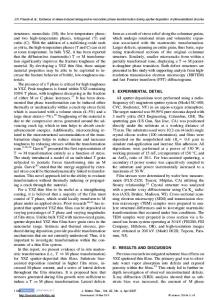Accurate determination of orientation relationships between ferroelastic domains: the tetragonal to monoclinic transitio
- PDF / 685,357 Bytes
- 6 Pages / 612 x 792 pts (letter) Page_size
- 87 Downloads / 265 Views
P5.6.1
Accurate determination of orientation relationships between ferroelastic domains: the tetragonal to monoclinic transition in LaNbO4 as an example. Ø. Prytz and J. Taftø Centre for Materials Science and Nanotechnology University of Oslo P.O.Box 1126 Blindern N-0316 OSLO, Norway ABSTRACT LaNbO4 crystallizes in a tetragonal high-temperature phase with space group I41/a, which transforms to a monoclinic phase upon cooling below 500 °C. The low-temperature phase has space group I2/a (C2/c) with a monoclinic angle β=94.1°. This system serves as a useful model of a ferroelastic transition of the 4/mF2/m type using the notation of Aizu [1]. This transition produces ferroelastic domains, the boundaries between which are parallel to the monoclinic baxis. The orientation of these boundaries relative to the monoclinic a- and c-axes has been predicted by Sapriel [2] for all 94 ferroelastic species, and calculations specifically for the LaNbO4 system have been presented by Jian and Wayman [3]. We present an accurate determination of the boundary orientation in LaNbO4 using selected area electron diffraction. The boundary planes are parallel to the (2 0 –5.10)/(5.10 0 2) planes of the two domains, as opposed to the predictions of Jian and Wayman which indicate that the domain boundaries should be oriented parallel to the (2 0 -4.04)/(4.04 0 2) planes. Our experimental results are in good agreement with the results of a previous study [4]. Furthermore, we present a simple geometric model for calculating the boundary orientation based only on the unit cell parameters of the monoclinic phase. This model gives a boundary orientation in excellent agreement with our experimental determination. INTRODUCTION AND THEORY Ferroelastic theory Ferroelectric or ferromagnetic materials display an electric or magnetic polarization even in the absence of external electric or magnetic fields, and are generally referred to as ferroic crystals. By applying an external field, this spontaneous polarization can be switched between different allowed orientation states. A third group of crystals is also part of this general class, they are referred to as the ferroelastic crystals. In complete analogy to the ferroelectric and ferromagnetic systems, these are crystals which, in the absence of external mechanical stress, possess a spontaneous strain tensor. By applying a mechanical stress, the crystal can change from one orientation state to another, thereby changing the spontaneous strain tensor. Aizu has described the 773 different species of ferroic crystal [1], and determined the orientation states and spontaneous strain tensors for the 94 species of ferroelastic crystals [5]. The origin of the ferroelastic orientation states is a structural phase transition from one crystal structure to another. Due to the symmetry of the structure before transformation, there may be several equivalent ways for such a transition to occur. As an example, we may consider the transformation from a cubic to a tetragonal system: here, any one of the three unit cell a
Data Loading...











